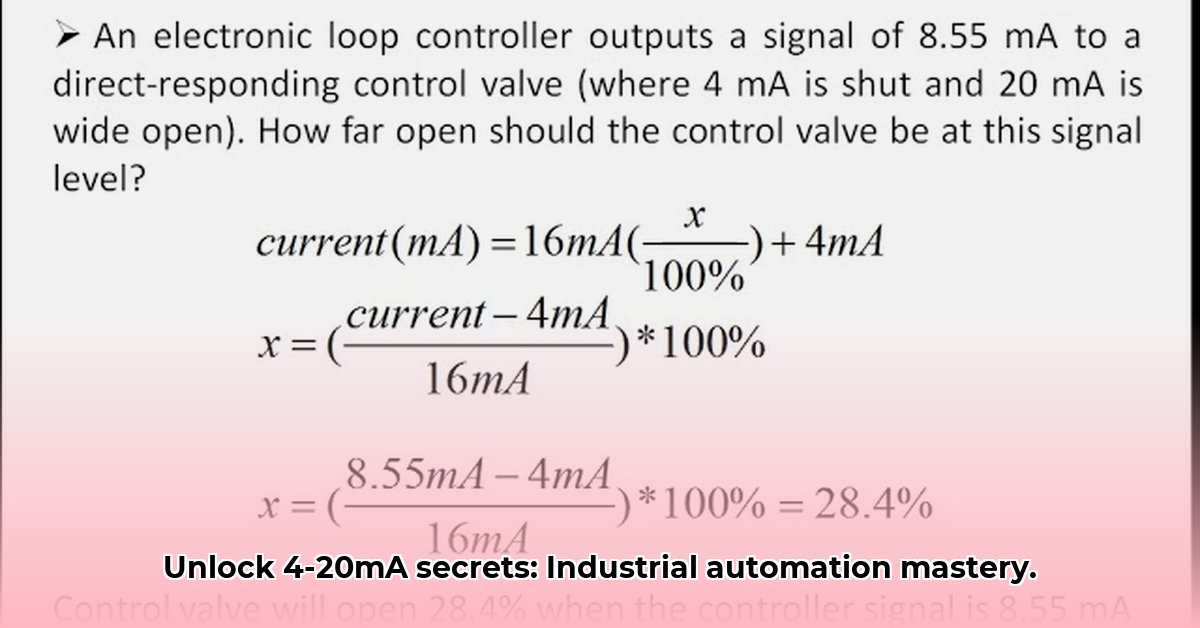
Understanding 4-20mA Signals in Industrial Automation
4-20 mA current signals are the backbone of many industrial processes, transmitting crucial data from sensors to control systems. These signals represent process variables like temperature, pressure, or flow rate. Accurately interpreting these signals is critical for efficient and safe operation. This guide provides a comprehensive walkthrough of calculating process values from 4-20 mA readings, covering various scenarios and emphasizing best practices. Understanding these calculations is essential for anyone involved in industrial automation. But what's the most effective method for accurate calculation, and how can we avoid common pitfalls?
Two Methods for 4-20mA Signal Conversion
Two primary methods exist for converting 4-20 mA signals into corresponding process values: the universal formula and a shortcut optimized for pressure transmitters. Let's explore each in detail.
Method 1: The Universal Formula
This versatile formula handles scenarios where the sensor's minimum reading isn't zero. It's applicable to a wider range of sensors and situations.
The formula is:
Process Value = ((Measured Current - Minimum Current) / (Maximum Current - Minimum Current)) * (Maximum Process Value - Minimum Process Value) + Minimum Process Value
Where:
Measured Current (I): The current reading from the sensor (mA).Minimum Current (I_min): The sensor's lowest current output (often 4 mA).Maximum Current (I_max): The sensor's highest current output (often 20 mA).Maximum Process Value (PV_max): The sensor's maximum measurable value.Minimum Process Value (PV_min): The sensor's minimum measurable value.
Have you ever encountered a situation where the standard formula proved insufficient? Understanding its limitations is crucial for selecting the appropriate calculation method.
Method 2: The Pressure Transmitter Shortcut
For pressure transmitters specifically, assuming 4 mA represents zero pressure, a simplified formula exists:
Pressure = ((Measured Current - 4 mA) / 16 mA) * Full Scale Pressure
Where:
Full Scale Pressure: The maximum pressure the transmitter can measure.
This method is simpler and faster, but its applicability is limited to pressure transmitters where 4 mA corresponds to zero pressure. Consider the potential for errors if this assumption is not valid. What are the implications of using this shortcut with a sensor that doesn't meet this criterion?
Comparing Calculation Methods: A Head-to-Head Analysis
Choosing the right method depends on the specific application and sensor characteristics. The table below summarizes the key differences:
| Feature | Universal Formula | Pressure Shortcut |
|---|---|---|
| Applicability | All sensors | Pressure transmitters (4 mA = 0 pressure) |
| Complexity | More complex | Simpler |
| Versatility | Highly versatile | Limited |
| Accuracy | Highly accurate with correct input values | Highly accurate within its limited scope |
Choosing between these methods hinges on the sensor type and required accuracy. A dedicated 4-20 mA calculator simplifies both methods.
Step-by-Step Example: Temperature Sensor Calculation
Let's illustrate the universal formula with a temperature sensor (0-100°C) producing a 12 mA reading:
Gather Data:
I = 12 mA,I_min = 4 mA,I_max = 20 mA,PV_min = 0 °C,PV_max = 100 °C.Apply the Formula:
Temperature = ((12 - 4) / (20 - 4)) * (100 - 0) + 0Calculate: The result is 50°C.
This straightforward example highlights the application of the universal formula. However, what steps should you take to ensure accuracy in more complex scenarios?
Safety and Regulatory Compliance: Minimizing Risks
Inaccurate 4-20 mA conversions can lead to significant issues. Regular sensor calibration and adherence to relevant safety regulations (e.g., IEC 61508 for functional safety) are paramount. Detailed documentation of processes and procedures is also critical for ensuring safety and maintaining compliance. "Regular calibration and safety protocols are essential for accurate and safe 4-20 mA signal interpretation," says Dr. Emily Carter, PhD, Control Systems Engineer at Automation Solutions Inc.
Leveraging Technology: Calculators and Simulators
Numerous online 4-20 mA calculators and software simulators are available. These tools significantly reduce calculation errors and allow for testing various scenarios before implementation.
Conclusion: Mastering 4-20mA Signal Conversion
Accurate 4-20 mA signal interpretation is essential in industrial automation. With the right understanding of calculation methods, tools, and safety protocols, you can reliably convert these signals into meaningful process data. Remember, accuracy and safety are paramount in industrial settings. Consistent application of proper techniques is key to achieving optimal performance and preventing costly errors.